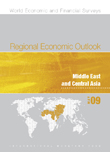Regional Economic Outlook:
Middle East and Central Asia
May 2009The global crisis is now affecting the countries in the Middle East and Central Asia region, and economic and financial vulnerabilities are rising. In the Middle East and North Africa, good economic fundamentals, appropriate policy responses, and sizable currency reserves are helping mitigate the impact of the shock. In the Caucasus and Central Asia, lower commodity prices and adverse economic developments in Russia have hit hard. The report notes that countries should prepare for the contingency of a prolonged global slowdown by supporting domestic demand for a longer period and strengthening financial systems further. In some countries with rising unemployment, it will be important to target government resources and policies on protecting the poor; in others, increased donor support will be necessary to maintain needed economic development. |
View the full text (use the free Adobe Acrobat Reader).
Contents
| Assumptions and Conventions | |
| Country and Regional Groupings | |
| Executive Summary | |
| Highlights | |
| I. Middle Eastern Oil Exporters: Continued Spending Supports the Global Economy | |
| II. Middle Eastern Oil Importers: Delayed Slowdown Under Way | |
| III. The Caucasus and Central Asia: A Bumpy Road Ahead? | |
| Statistical Appendix | |
| Boxes | |
| 1 | World Economic Outlook |
| 2 | Middle Eastern Oil Exporters’ Sovereign Wealth Funds: Impact and Implications of the Global Crisis |
| 3 | Linkages and Spillovers with the GCC Region and with Europe |
| 4 | How Important Are Different Forms of Foreign Inflows to Middle Eastern Oil Importers? |
| 5 | How Russia Affects the Neighborhood: Trade, Financial, and Remittance Channels |
| 6 | Exchange Rate Policies: Coping with New Challenges in Caucasus and Central Asia Countries |
| Figures | |
| 1 | Credit Default Swaps |
| 2 | Real Estate Price Index |
| 3 | MEOEs: Change in Stock Market Indices |
| 4 | MEOEs: Current Account Balance |
| 5 | MEOEs: Government Fiscal Balance |
| 6 | Imports of Goods and Services |
| 7 | MEOIs: Change in Stock Market Indices |
| 8 | Sovereign Bond Spreads |
| 9 | MEOIs: Real GDP Growth |
| 10 | Consumer Price Inflation |
| 11 | Effective Exchange Rates |
| 12 | MEOIs: Current Account Balance |
| 13 | MEOIs: Government Fiscal Balance |
| 14 | CCA: Real GDP Growth |
| 15 | Trade Patterns in the CCA, 2008 |
| 16 | Remittance Inflows |
| 17 | Remittance Outflows from Russia |
| 18 | Remittance Receipts |
| 19 | CCA: Government Fiscal Balance |
| 20 | CCA: Current Account Balance |
| 21 | Average Inflation, GDP-Weighted |
| 22 | Private External Debt, 2008 |
| 23 | Credit Growth |
| 24 | Nonperforming Loans |
| 25 | Capital Adequacy Ratios |
| 26 | Existing House Prices |
| 27 | Foreign Exchange Share of Loans and Deposits, End-2008 |
| 28 | CCA: Government Fiscal Balance |
| 29 | Sovereign Wealth Fund Assets and Public Debt, 2008 |
| Tables | |
| 1 | Middle Eastern Oil Exporters: Summary of Crisis Response Measures |
| 2 | Growth and Inflation, 2007–10 |
| 3 | Banking Sector Performance and Soundness |
| 4 | Financial Soundness Indicators, 2008 |
| 5 | Middle Eastern Oil Importers: Summary of Crisis Response Measures |
| 6 | Tax Revenue |
| 7 | The Caucasus and Central Asia: Real GDP Growth |
| 8 | The Caucasus and Central Asia: Summary of Crisis Response Measures |
| Statistical Appendix Tables | |
| 1 | Real GDP Growth |
| 2 | Nominal GDP |
| 3 | Oil and Non-Oil Real GDP Growth for Oil Exporters |
| 4 | Crude Oil Production and Exports |
| 5 | Consumer Price Inflation |
| 6 | Central Government Fiscal Balance |
| 7 | Broad Money Growth |
| 8 | Central Government Total Revenue, Excluding Grants |
| 9 | Oil Exporters: Central Government Non-Oil Fiscal Balance |
| 10 | Oil Exporters: Central Government Non-Oil Revenue |
| 11 | Central Government Total Expenditure and Net Lending |
| 12 | Total Government Debt |
| 13 | Exports of Goods and Services |
| 14 | Imports of Goods and Services |
| 15 | Current Account Balance (in billions of U.S. dollars) |
| 16 | Current Account Balance (in percent of GDP) |
| 17 | Gross Official Reserves |
| 18 | Total Gross External Debt |



